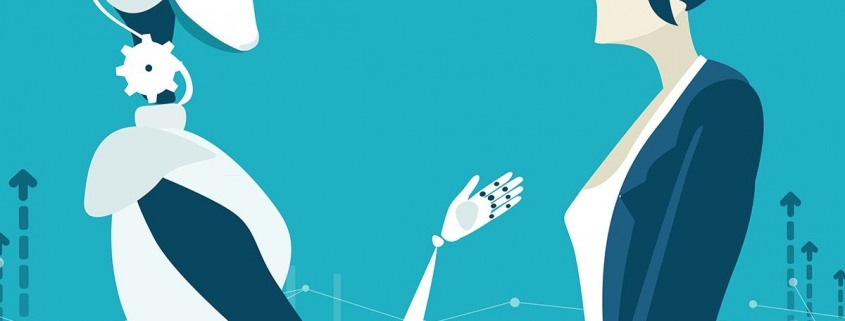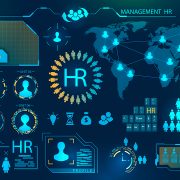AI & People Represent the Future of Work
Too many business leaders still believe that AI is just another ‘plug and play’ incremental technological investment. In reality, gaining a competitive advantage through AI requires organisational transformation of the kind exemplified by companies leading in this era: Google, Haier, Apple, Zappos, and Siemens. These companies don’t just have better technology — they have transformed the way they do business so that human resources can be augmented with machine powers.
While no one knows what artificial intelligence’s effect on work will be, we can all agree on one thing: it’s disruptive. So far, many have cast that disruption in a negative light and projected a future in which robots take jobs from human workers. That’s one way to look at it. Another is that automation may create more jobs than it displaces. By offering new tools for entrepreneurs, it may also create new lines of business that we can’t imagine now.
A recent study from Redwood Software and Sapio Research underscores this view. Participants in the 2017 study said they believe that 60 percent of businesses can be automated in the next five years. On the other hand, Gartner predicts that by 2020 AI will produce more jobs than it displaces. Dennis Mortensen, CEO and founder of x.ai, maker of AI-based virtual assistant Amy, agreed. “I look at our firm and two-thirds of the jobs here didn’t exist a few years ago,” said Mortensen.
In addition to creating new jobs, AI will also help people do their jobs better — a lot better. At the World Economic Forum in Davos, Paul Daugherty, Accenture’s Chief Technology and Innovation Officer summed this idea up as, “Human plus machine equals superpowers.” For many reasons, the optimistic view is likely the more realistic one. But AI’s ability to transform work is far from preordained. In 2018, workers are not being adequately prepared for their futures. The algorithms and data that underlie AI are also flawed and don’t reflect the diverse society it’s meant to serve.
How AI Could Grow Jobs: Inventing New Ones, Empowering Existing Ones
While AI will certainly displace some jobs, such displacement has occurred long before AI was on the scene. In the past century, we’ve seen the demise or diminishment of titles like travel agent, switchboard operator, milkman, elevator operator and bowling alley pinsetter. Meanwhile, new titles like app developer, social media director, and data scientist have emerged.
Daugherty and Jim Wilson, managing director of Information Technology and Business Research at Accenture Research have co-authored a book titled Human + Machine: Reimagining Work in the Age of AI. In their view, future (and current) jobs include trainers and explainers. Trainers will teach AI systems how to perform and mimic human behaviours.
Empowering Workers, Businesses and Industries
Rather than replacing workers, AI can be a tool to help employees work better. A call center employee, for instance, can get instant intelligence about what the caller needs and do their work faster and better. That goes for businesses and industry too. In another example, in life sciences, Accenture is using deep learning and neural networks to help companies to bring treatments to market faster.
In addition to helping existing businesses, AI can create new ones. Such new business include digital-based elder care, AI-based agriculture and AI-based monitoring of sales calls. Finally, automation can be used to fill currently unfilled jobs. As Daugherty noted recently, there is a shortage of 150,000 truck drivers in the U.S. right now. “We need automation to improve the productivity of the drivers, the lifestyle of the drivers to attract more people to the industry,” he said.
The Value of Human and Machine Working Together
AI technology can boost business productivity by up to 40 per cent, according to Accenture. But while business leaders may rejoice at that fact, 72 per cent of employees fear AI stealing their jobs, Pew Research found.
However, the adoption of AI doesn’t mean a wipeout of work available to humans. While some tasks may be trusted completely to AI, like the algorithms that drive recommendation engines on platforms like Netflix, Amazon, and Spotify, others are reserved for human skill only.
For instance, because AI cannot offer empathy or emotion, traits native only to humans, it likely won’t have an applicable role in practice areas like psychotherapy, social work or in-depth customer service.
There’s also a third category of work: the kind best done by humans and AI working in tandem. In the case of many tasks, AI can help get progress started, but it still requires a human to complete the job by verifying the accuracy or providing more context. These gray areas include services like accuracy checks and human interaction.
While AI may not complete such tasks perfectly on its own, there is still value in keeping AI a part of the process. The ideal AI-human arrangement is one in which AI technology drives the lower-level, repetitive processes associated with completing a task, while human oversight ensures the timely and accurate completion of that task.
AI-Human Teams in Action
So where can we see this tag-team dynamic in action? The voice transcription space serves as one example.
Quick and accurate voice-to-text technology plays an important role in the deaf and hard of hearing community, as well as the higher education and legal industries. AI can transcribe human speech much faster than humans can—in a controlled environment, that is.
But the everyday need for voice transcription doesn’t always come in the form of a controlled environment. AI only hits peak accuracy when the speech mimics the kind it was trained on. We can’t rely on AI alone to transcribe voice perfectly when the accent, speed, diction, and tone of the speech vary, or if background noise is present.
However, it’s most efficient to give AI the first crack at it and employ the help of humans to verify accuracy and fix errors if needed. Taking this approach has enabled faster access to high-quality voice transcription than ever before.
Teams that rely on fast voice transcription are reaping the benefits of humans and AI perfecting the practice. Courts, for example, face a court reporter shortage, with an estimated 70 per cent of the workforce expected to retire over the next 10 years. AI and human-powered voice transcription will help fill in the gaps.
Students — whether deaf, hearing-impaired or with no hearing issues — all benefit from timely access to the transcriptions of course lectures. Deaf and hearing-impaired students deserve the chance to keep up with their hearing classmates, and not all hearing students learn best by listening.
While AI has earned its place it every industry, it doesn’t always perform best on its own. Enlisting the help of humans brings it to its full potential and allows us all to take full advantage of a powerful technology, making a true difference in end-users’ lives.
Given our current situation knowing that your colleagues or employees are best suited for this new scenario we find ourselves in. Finding the right talent, the best fit for the job and your organisation can be a very challenging task. It is now important to find out whether your managers or your team is well-equipped of working together from various locations. It requires deep knowledge of their personalities, strengths, weaknesses, interests, work style and other characteristics. Our technology and solutions will do the work for you, helping you discover if your people are resilient during times of hardship, if they are autonomous, if they are team players, without actual human contact. Given that our platform is cloud-based, everyone can use it from home as well. Humanity finds itself at a crossroad for various reasons now, why not help people discover and develop themselves from the comfort of their own homes?
Request a free demo:

Sources:
https://www.entrepreneur.com/article/329099
https://www.wired.com/wiredinsider/2018/04/ai-future-work/
https://hbr.org/2020/08/the-secret-to-ai-is-people











